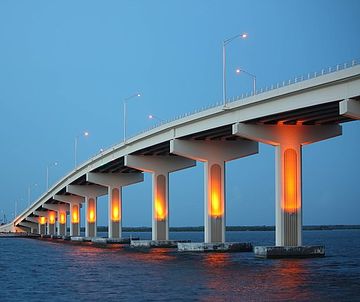Indian River Bridges
Bridges and Causeways crossing the Indian River lagoon.
Until 1920, there were only two bridges spanning across the Indian River, one in Brevard County's Cocoa and the second in Martin County's Hobe Sound.
On Labor Day in 1920, a new wooden Vero Bridge opened and access to the ocean was available to all who lived on the Vero mainland. For boat traffic, a bridge tender, who lived in a house near the middle of the crossing, would open the metal swing span by hand. Tolls were charged to cross the bridge, ranging from 5 cents for pedestrians, 10 cents for horses and 35 cents for delivery trucks.[1]
In 1925, construction began on the first wooden bridge across the Indian River Lagoon in Eau Gallie. On February 22, 1926, the bridge opened to vehicle traffic headed to a sand trail at Canova Beach. There was no railing on the bridge for a year after its construction. There are no records that anyone fell off the bridge during this time.[2]
Post War 1940's the U.S. government funded construction of new bridges across the Indian River.
As Florida's population grew, more traffic headed to the barrier islands, and modern bridges created from steel and concrete were constructed. These early concrete and steel bridges used earthen berths to partially span the river, with a lift or swing drawbridge in the middle to allow tall boats to pass.
A boat unable to pass under the bridge would signal the tender, who was in a shack hanging off the bridge's side, to open the drawbridge so they could pass through. In less populated areas, the drawbridges were unattended at night and boats would have to anchor, and await the bridge tender's return the next morning.
A lagoon does not have a typical river type current, their water is only moved by wind and a minor tidal flow.
Earthen berm causeways contribute to the Indian River's health problems by impeding the lagoon's water flow, limiting it's ability to flush out stagnant water containing algae, bacteria, dead seagrass and pollutants.
Recently the river's communities have recognized the harm these old berm bridges cause, and are requiring high rise bridges that span the entire river.
Bridge Info Table
| Name | Water | Road | County | Article | |
|---|---|---|---|---|---|
| Name | Water | Road | County | Article | |
| Alma Lee Loy Bridge (info) | Central Indian River | CR656 | Indian River | ||
| Eau Gallie Causeway (info) | North Indian River | SR518 | Brevard | ||
| Ernest Lyons Bridge (info) | South Indian River | A1A | Martin | ||
| Max Brewer Bridge (info) | North Indian River | SR406 | Brevard | Max Brewer Bridge | |
| Merrill Barber Bridge (info) | Central Indian River | SR60 | Indian River | Merrill Barber Bridge | |
| NASA Causeway Indian River (info) | North Indian River | SR405 | Brevard | ||
| Pineda Causeway (info) | North Indian River | SR404 | Brevard | ||
| Sebastian Inlet Bridge (info) | Central Indian River | A1A | Brevard | Sebastian Inlet | |
| Wabasso Bridge (info) | Central Indian River | SR510 | Indian River | Wabasso Bridge |
Bridge List
Brevard County
- NASA Railroad Bridge
- A. Max Brewer Memorial Parkway SR406 (info)
- NASA Parkway Causeway SR405 (info)
- Beachline Causeway SR528
- Hubert Humphrey Bridge SR520
- Pineda Causeway SR404 (info)
- Eau Gallie Causeway SR518 (info)
- Melbourne Causeway US192
- Sebastian Inlet Bridge A1A (info)
Indian River County
- Wabasso Causeway SR510 (info)
- Merrill P. Barber Bridge (info)
- Alma Lee Loy Bridge SR656 (info)
St. Lucie County
- North Causeway USA1A
- Seaway Drive Causeway USA1A
Martin County
- Frank Wacha Bridge CR732
- Ocean Blvd Causeway
- Ernest Lyons Bridge A1A (info)
- Evans Crary Bridge A1A - St.Lucie River
- Roosevelt Bridge US1 - St. Lucie River (info)
- SE Bridge Rd. Causeway CR707
Palm Beach County
- South Beach Road Causeway CR707


